Contributor Anna Bruce takes a deep dive into how fermentation tinas are made and why, once again, every part of the mezcal production process matters in ways you might not suspect
Sipping a mezcal at the distillery where it was made is one of my favourite things to do. The smell of production will forever inform your tasting experience. The rich aroma of fermenting agave fills the air. It smells like toffee apples with a hint of vinegar, or scrumpy cider with smoky caramel, sweet and tart.
Fermentation is one of the key steps in the mezcal process that influences flavor. In Oaxaca, fermentation for artisanal-style mezcal typically takes place in wooden tubs, open to allow for wild yeast to work on the cooked agave sugars, creating a mosto unique to the location. These wooden vessels are called tinas (meaning tub or tank).
When you visit an artisanal palenque in Oaxaca, tinas are an iconic feature of the space. Most palenques have at least a couple, usually filled with aromatic pulverized agave in various stages of fermentation. In larger distilleries there can be dozens.

The tinas can vary in dimensions, depending on the region, style, and overall scale of the mezcal production. Some are numbered or even emblazoned with names .
Mezcaleros treat their tinas with the utmost respect, honoring one of the most vital stages of making mezcal. As with all details in the production of artisanal or ancestral mezcal, this seemingly simple component is an expression of deep tradition and attention to detail.
Recently I visited Casa Palacios, where they produce Salvadores mezcal. They were redoing the floor of the distillery to make a more secure base for their new fermentation tinas. Casa Palacios was built in 2019, and all the elements of the palenque were designed to be beautiful yet efficient.
The sculptural wooden tinas take up the central space at the distillery. These tubs are made by master craftsman Antonio López, whose workshop El Fenix is in San Francisco Lachigolo, about thirty minutes from the city center of Oaxaca. We were fortunate enough to be invited to meet the master himself at his workshop, where he has been making tinas since 2003.
From craftsman to specialist
Upon first arrival, the shop looks a bit understated but very clean. Freshly cut slats leaning against the wall are emblazoned with numbers and the logos of various mezcal brands. Antonio greets us and introduces us to his son Beto. He speaks passionately about his craft, clearly enamored with both innovations and the history of this work.

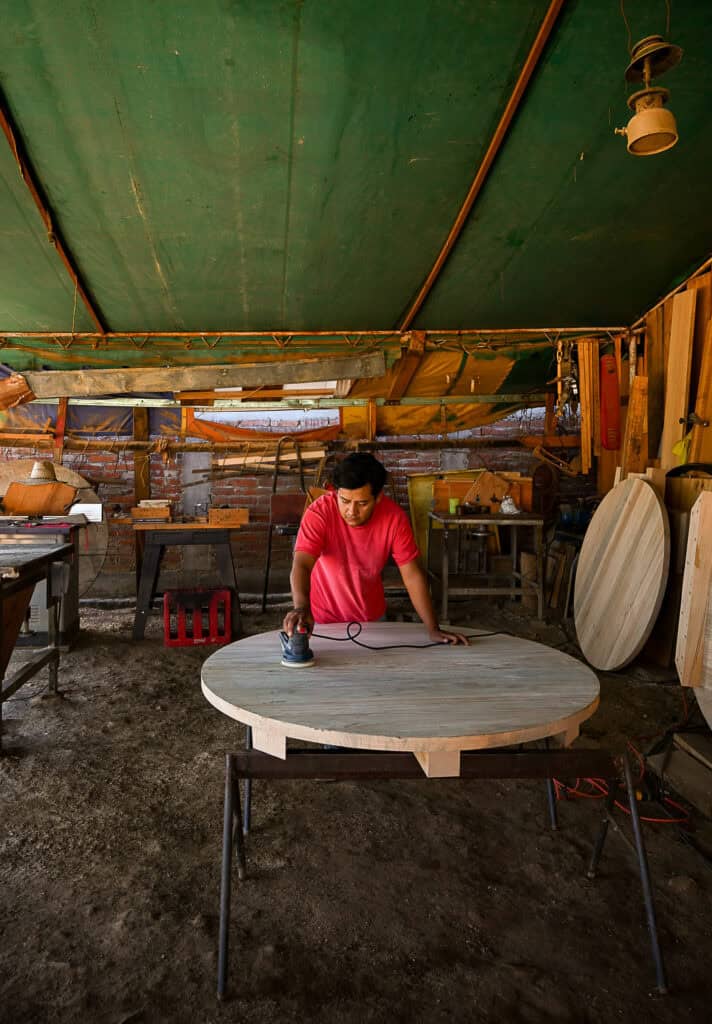
El Fenix refers to a phoenix rising from the ashes, and the logo is burnt with a laser into the side of each of the tinas. Antonio has had some personal struggles in his past, so it’s a name that celebrates overcoming these with his passion for making quality tinas.
When Antonio moved to Oaxaca from Veracruz, he was already a carpenter. After meeting Victor Manuel Chagoya Mendez, he began to focus purely on making fermentation tinas. Chagoya had been outsourcing most of the production to Zacatecas, but said he wanted Antonio to make the tinas. “20 years ago Chagoya sent me to do work for him. One day he said, ‘Master, make me some vats,’ and I made them for him,” Antonio remembers.
He and his son work together in the family business. Beto explains that they had tried employing a larger team, but they had some issues.
“We decided that we are going to do what we can between the two of us. We started to make a production chain and have made a lot of progress,” he says.
The pride they take in their craft is clear to see. They take turns explaining that each tina is its own work of art and built to last with care.
How are fermentation tinas made?
Wood used for the tinas is in its natural state, with no extra finishes, and must meet a high standard.
Although many newer tinas are made with pine, traditionally these tubs were made from a type of cypress known locally as sabino. Sabinos are sacred to the Zapotec community and have been Mexico’s national tree since 1910.
Antonio and Beto mostly mostly use pine, although they make tinas of sabino on request. Antonio says the master mezcaleros still prefer using sabino. But today it is a scarce wood, controlled by SEMARNAT (Mexico’s secretary of the environment and national resources.)
Sabinos are semi-evergreen trees, commonly found growing along river banks and marshes. The nahuatl name for them is ahuehetl or ahuehuete, sometimes interpreted as “old man of the water”–which makes sense when you see their wrinkled buttresses reaching down into the rivers of Sola de Vega.
The most famous Sabino is the “Tule Tree”, which is thought to be around 1500 years old. It’s the stoutest tree in the world, with a diameter of over 14 meters–and still growing. The Tule Tree is so large that it was originally thought to be multiple trees, but DNA tests have proved it to be a single entity.
Sabino is sought after for fermentation tubs because it’s much lighter than pine and has desirable natural oils and water-wicking properties. Because the trees are rare and protected, the cost of sabino is almost double. A standard size tina in pine is 14900 pesos, while the sabino version costs 29900 pesos.
Pine is more commercial, seals well, and still gives good results. “Pine or sabino are first-class woods; they are kiln-dried woods; they are quality woods from controlled forests,” Antonio says.
“Fibers are where microorganisms are trapped, which help the fermentation to be a little faster and with a better flavor,” Antonio explains. He thinks the wood contributes some flavor to the ferment, but points out that the added flavor is likely minimal because the fermentation time is relatively short–in contrast to the strong influence of wood when aging spirits for months at a time in barrels.
It takes around six hours to assemble a standard size tina, which holds around 1200 liters, or more than a ton of fermenting agave. The standard is approximately 140 centimeters in diameter and 100 cm high, with walls about 42 mm thick. It can hold more than a ton of fermenting matter.
To rush it would lower the quality. “We try to give love to everything we do.”

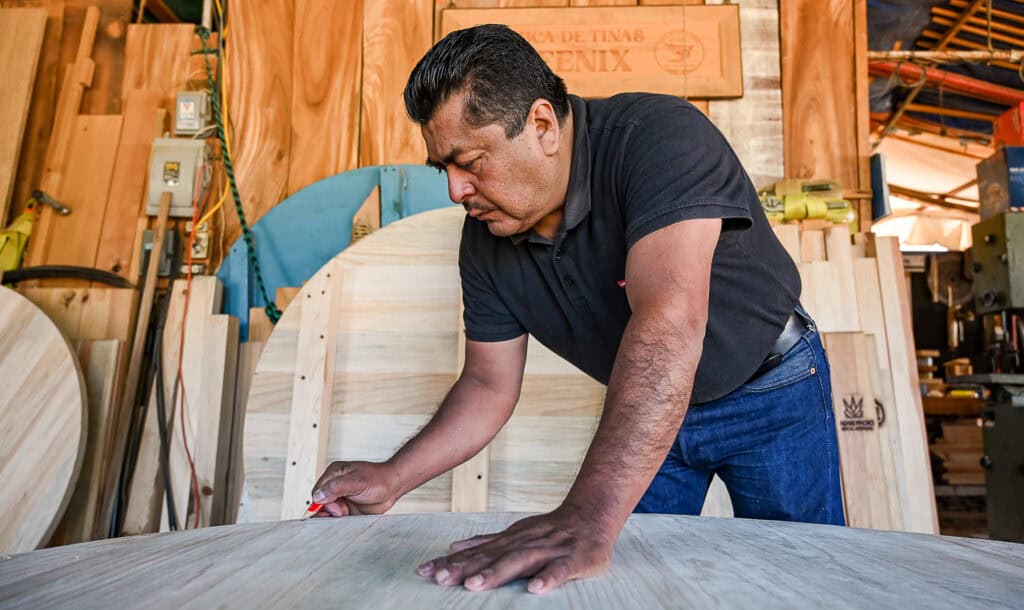


El Fenix produces for many brands. Most ask for a standard size tina, but of course there are exceptions. Producers in Santa Catarina Minas ask for smaller vats to help ferment faster–600 liters. Larger distilleries may ask for huge tinas because they want a consistent fermentation for a massive batch.
Some producers are exploring how the shape and volume of tinas can influence the fermentation and final flavors in mezcal. For example, thicker walls could insulate the tinas, allowing for a more consistent fermentation.
Beto explained that although some details will have an effect on the ferment, there is at least one misplaced assumption. He says that when the tinas are tall and bowed in at the top, this is an issue with construction that has been passed off as having an effect on the ferment.
They use an assembly technique called tongue and groove. Rather than just having planks bound together around a circular base, the edges of the boards are designed to fit together like puzzle pieces. Antonio says that this method dates back to 1885, developed in Austria.


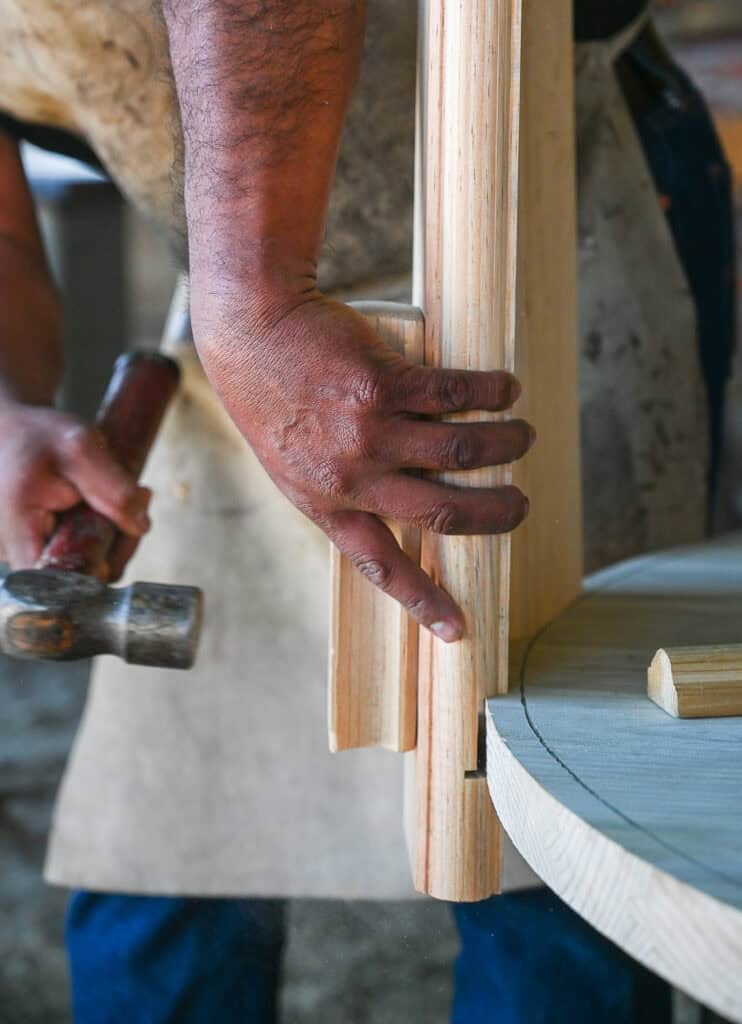

Each section is pre-made and then pieced together. Antonio uses a mirror so he can see the quality of the joint. “They have a depth of 1 cm, 1 cm of entry, and that gives us a more rigid vat,” he explains. “It is stronger when you lift it… And with the part below, which has that curve–well, it gives it more rigidity.”
Adding the metal bands to hold the tub together is one of the most challenging steps to making the tinas. Initially Antonio struggled with this part of the process. A builder friend helped him develop his method. He ordered a special table that helps him get the band sufficiently tight. “Taught like violin strings,” he says.
As distilleries become more refined, aesthetics are important. Antonio and Beto now paint the metal bands to prevent rust from staining the wood. They carefully sand each vat. This is partly to make them beautiful and comfortable to use, but it also improves the seal. They work with a company who can burn designs using a laser. As well as the El Fenix logo, they also number each fermentation tina to make it easier for the mezcal producers to keep track of the flow of fermentation to distillation.

Once the tina is filled with liquid, it swells and becomes completely watertight. These premium tinas are better for fermenting volatile agaves like jabali, which are known for foaming up during fermentation.
Once a mezaclero has first filled a tina, it’s important that it never dries out. So between fermentations, you will usually see the tubs filled with water. Antonio explains that the wood is always shrinking and swelling.
“The wood is always working. From the moment you start using it, it should be kept moist. It should not be allowed to dry out, because the wood tends to shrink. It is very important that it does not become loose, although right now we are putting in this system with screws so that it can be adjusted.”
Mezcaleros have told me the tinas can last around 20 years. Antonio says a decade is more likely, although sabino will last longer.
“It takes forever to dry out, it retains a lot of moisture,” he says.
Antonio has been making tinas for alternative uses. For example Sombra mezcal hired El Fenix to make a wooden tina-style cooling tank for distillation. Antonio remembers this was his largest ever tub. Lately, boutique hotels in Oaxaca have commissioned him to make tinas to use for hot tubs.
Through their work Antonio and Beto have also met many mezcal producers. Beto says that often their clients would give them mezcal, which helped him to develop a taste for it. Now he is collaborating with a mezcalero in Albarradas on a small batch brand called Cerro Salvaje.
Antonio recently contributed one of his tinas for a raffle to raise money for the church in Santa Catarinas. From this he was recommended to build tinas for a new production in Guanajuato. His quality work for El Fenix is drawing more and more customers. The success of their craft has enabled them to buy the land for their workshop, and they hope to expand it in the future.


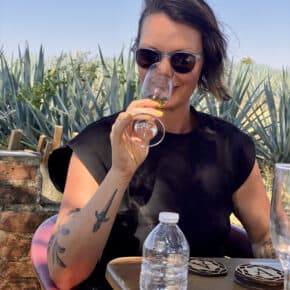


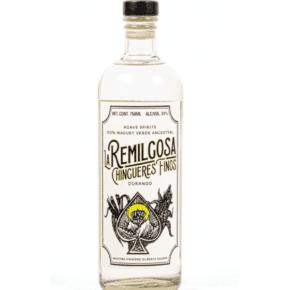








Leave a Comment